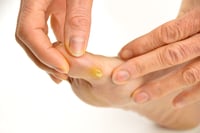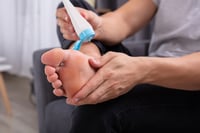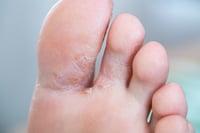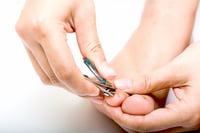
Diabetic foot care is important no matter the season.
But winter can present some unique challenges for people with diabetes, as they face threats like dry skin, increased numbness and decreased circulation.
The right diabetic footwear is important this time of year, whether that means diabetic socks, shoes or diabetic inserts. But proper footwear can only do so much. It’s important to take steps each day to make sure your feet are well cared for when winter comes.
 1. Do a daily foot inspection
1. Do a daily foot inspection
This first tip should be part of your routine all year round. Inspect your feet each day for changes in color to the skin, breaks in the skin, corns and calluses and any discharge. You should also check your socks for stains and your shoes for stones.
2. Make sure your feet stay dry
If you’re outside during snowy or slushy weather, make sure you dry your feet when you get back indoors. Moisture that soaks through your socks and gets between your toes can cause bacteria to form.
Whether you’re coming in from outside or just getting out of the shower, dry yourself gently, thoroughly and carefully, making sure to get between your toes. Make sure you change out of wet socks as soon as you can.
3. Cut your toenails
Toenails that are too long can lead to ulcers or infections. Your doctor can advise you on the proper way to trim your nails. Soak your feet first to make the nails softer and then cut them straight across.
If your nails are discolored or too thick, or if you have trouble trimming your nails, you might need professional assistance. Medicare might cover this nail care if you have a history of nail-related problems.
4. Use a moisturizer
 The lowered circulation and nerve damage that come with diabetes can cause the moisture-producing glands in the foot to lose function. Dry winter air – like what you’d experience in an hour-long car ride with the heat blasting – can make this dryness even worse and cause your skin to break down.
The lowered circulation and nerve damage that come with diabetes can cause the moisture-producing glands in the foot to lose function. Dry winter air – like what you’d experience in an hour-long car ride with the heat blasting – can make this dryness even worse and cause your skin to break down.
When you do your daily inspect, check for red areas and apply a good moisturizer after your daily shower. Your doctor can recommend one that will work best for people with diabetes. Just make sure you don’t leave too much moisturizer between your toes.
5. Use caution when warming your feet
 Diabetic nerve damage can make warming your feet a dangerous proposition in some cases. You might not be able to tell when something is too hot, whether it’s a heating pad, electric blanket or just the water in your bathtub.
Diabetic nerve damage can make warming your feet a dangerous proposition in some cases. You might not be able to tell when something is too hot, whether it’s a heating pad, electric blanket or just the water in your bathtub.
Check water temperature with your hands or a thermometer before submerging your feet. Getting a burn on your foot can lead to serious problems when you have diabetes, so if you do burn yourself, get it treated right away.
6. Wear the right shoes
 Make sure the shoes you’ve chosen provide warmth and protection from snow and ice. They should also include some padding and fit well enough that they aren’t cutting off blood flow to your feet.
Make sure the shoes you’ve chosen provide warmth and protection from snow and ice. They should also include some padding and fit well enough that they aren’t cutting off blood flow to your feet.
If you’re searching for a new pair of diabetic shoes or diabetic inserts this winter, visit Marx Medical Equipment, where our team is dedicated to providing you with safe and comfortable diabetic footwear.
We work with Dr. Comfort, maker of custom diabetic shoes designed to improve circulation and reduce injury, all while looking great.
Come to our store at 2814 East Allegheny Ave. Philadelphia, PA 19134 and we will help you find the right pair of diabetic inserts or shoes for you.



